[54 Pa.B. 3353]
[Saturday, June 15, 2024]
[Continued from previous Web Page]
Annex A
TITLE 22. EDUCATION
PART I. STATE BOARD OF EDUCATION
Subpart A. MISCELLANEOUS PROVISIONS
CHAPTER 4. ACADEMIC STANDARDS AND ASSESSMENT (Editor's Note: The academic standards appendices are proposed to be added to the table of contents following § 4.83, as follows.)
ACADEMIC STANDARDS Appx.
Appendix A [Reserved]
Appendix A-1 [Reserved]
Appendix A-2 Pennsylvania Core Standards for English Language Arts and Mathematics
Appendix B Academic Standards for Science and Technology and Environment and Ecology (Editor's Note: Appendix B is proposed to expire July 1, 2025.)
Appendix B-1 Pennsylvania Integrated Standards for Science, Environment, Ecology, Technology and Engineering (Grades K—5), Pennsylvania Integrated Standards for Science, Environment and Ecology (Grades 6—12), and Pennsylvania Technology and Engineering Standards (Grades 6—12) (Editor's Note: Appendix B-1 applies on and after July 1, 2025.)
Appendix C Academic Standards for Civics and Government and Economics and Geography and History and the Pennsylvania Core Standards for Reading in History and Social Studies and Pennsylvania Core Standards for Writing in History and Social Studies (Editor's Note: The standards for Economics in Appendix C are proposed to expire July 1, 2026.)
Appendix C-1 Academic Standards for Economics (Editor's Note: Appendix C-1 is proposed to apply on and after July 1, 2026.)
Appendix D Academic Standards for Arts and Humanities and Health, Safety and Physical Education and Family and Consumer Sciences (Editor's Note: The standards for Family and Consumer Sciences in Appendix D are proposed to expire July 1, 2026.)
Appendix D-1 Academic Standards for Family and Consumer Sciences (Editor's Note: Appendix D-1 is proposed to apply on and after July 1, 2026.)
Appendix E Academic Standards for Career Education and Work (Editor's Note: Appendix E is proposed to expire July 1, 2026.)
Appendix E-1 Academic Standards for Career Education and Work (Editor's Note: Appendix E-1 is proposed to apply on and after July 1, 2026.)
Appendix F Academic Standards for Personal Finance (Editor's Note: Appendix F is proposed to apply on and after July 1, 2026.)
ACADEMIC STANDARDS AND PLANNING § 4.11. Purpose of public education.
* * * * * (g) Public schools provide instruction throughout the curriculum so that students may develop knowledge and skills in the following areas:
(1) English language arts.
(2) Mathematics.
(3) Science and environment and ecology.
(4) Technology and engineering.
(5) Social studies (civics and government, geography, economics and history).
(6) Arts and humanities.
(7) Career education and work.
(8) Health, safety and physical education.
(9) Family and consumer [science] sciences.
(10) Personal finance.
(h) Public education provides planned instruction to enable students to attain academic standards under § 4.12. Planned instruction consists of at least the following elements:
(1) Objectives of a planned course, instructional unit or interdisciplinary studies to be achieved by all students.
(2) Content, including materials and activities, and estimated instructional time to be devoted to achieving the academic standards. Courses, instructional units or interdisciplinary studies of varying lengths of time may be taught.
(3) The relationship between the objectives of a planned course, instructional unit or interdisciplinary studies and academic standards specified under § 4.12 and any additional academic standards as determined by the school entity.
(4) Procedures for measurement of the objectives of a planned course, instructional unit or interdisciplinary studies.
§ 4.12. Academic standards.
(a) School entities may develop, expand or improve existing academic standards in the following content areas:
(1) The following apply:
(i) Through June 30, 2025: Science and technology. Study of the natural world and facts, principles, theories and laws in the areas of biology, chemistry, physics and earth sciences. Technology is the application of science to enable societal development, including food and fiber production, manufacturing, building, transportation and communication. Science and technology share the use of the senses, science processes, inquiry, investigation, analysis and problem solving strategies. The Pennsylvania Core Standards for Reading in Science and Technology and the Pennsylvania Core Standards for Writing in Science and Technology will be an appendix to the Commonwealth's academic standards for Science and Technology upon publication in the Pennsylvania Bulletin.
(ii) Effective July 1, 2025: Pennsylvania Integrated Standards for Science, Environment, Ecology, Technology and Engineering (Grades K—5). Guide the elementary-level study of the natural and human-made world through inquiry, problem-solving, critical thinking and authentic exploration. The integration of these disciplines in the elementary grades highlights the interconnectedness of scientific study and the integral relationship between humans and the environment.
(2) The following apply:
(i) Through June 30, 2025: Environment and ecology. Understanding the components of ecological systems and their interrelationships with social systems and technologies. These components incorporate the disciplines of resource management, agricultural diversity, government and the impact of human actions on natural systems. This interaction leads to the study of watersheds, threatened and endangered species, pest management and the development of laws and regulations.
(ii) Effective July 1, 2025: Pennsylvania Integrated Standards for Science, Environment and Ecology (Grades 6—12). Utilize a three-dimensional approach to guide the study of physical sciences, life sciences, and earth and space sciences at the middle and high school levels. The standards highlight the critical intersections of these disciplines with environmental science, ecology, and agriculture. These three-dimensional standards integrate disciplinary core ideas, practices in science and engineering, and crosscutting concepts into coherent learning progressions across the grade bands.
(iii) Effective July 1, 2025: Pennsylvania Technology and Engineering Standards (Grades 6—12). Define the knowledge, skills, and abilities necessary for establishing literacy in technology and engineering literacy. Students develop a practical understanding of how humans are influenced by science and technology. Four core disciplinary standards describe practices in technology and engineering and include specific benchmarks for students in grade bands 6—8 and 9—12.
(2.1) Appendix B (relating to academic standards for science and technology and environment and ecology shall expire July 1, 2025. The academic standards under paragraphs (1)(ii) and (2)(ii) and (iii) shall be based on the provisions of Appendix B-1 (relating to Pennsylvania integrated standards for science, environment, ecology, technology and engineering (Grades K—5), Pennsylvania integrated standards for science, environment and ecology (Grades 6—12), and Pennsylvania technology and engineering standards (Grades 6—12)) on and after July 1, 2025.
(3) Social studies.
(i) History. Study of the record of human experience including important events; interactions of culture, race and ideas; the nature of prejudice; change and continuity in political systems; effects of technology; importance of global-international perspectives; and the integration of geography, economics and civics studies on major developments in the history of the Commonwealth, the United States and the world.
(ii) Geography. Study of relationships among people, places and environments, of geographic tools and methods, characteristics of place, concept of region, and physical processes.
(iii) Civics and government. Study of United States constitutional democracy, its values and principles, study of the Constitution of the Commonwealth and government, including the study of principles, operations and documents of government, the rights and responsibilities of citizenship, how governments work and international relations.
(iv) Economics. Study of how individuals and societies choose to use resources to produce, distribute and consume goods and services. Knowledge of how economies work, economic reasoning and basic economic concepts, economic decision making, economic systems, the Commonwealth and the United States economy and international trade. The academic standards for Economics in Appendix C (relating to academic standards for civics and government and economics and geography and history and the Pennsylvania core standards for reading in history and social studies and Pennsylvania core standards for writing in history and social studies) shall expire July 1, 2026. The academic standards under this subparagraph shall be based on the provisions of Appendix C-1 (relating to academic standards for economics) on and after July 1, 2026.
(v) Appendix. The Pennsylvania Core Standards for Reading in History and Social Studies and the Pennsylvania Core Standards in Writing for History and Social Studies will be an appendix to the Commonwealth's academic standards for History upon publication in the Pennsylvania Bulletin.
(4) Arts and humanities. Study of dance, theatre, music, visual arts, language and literature including forms of expression, historical and cultural context, critical and aesthetic judgment and production, performance or exhibition of work.
(5) Career education and work. Understanding career options in relationship to individual interests, aptitudes and skills including the relationship between changes in society, technology, government and economy and their effect on individuals and careers. Development of knowledge and skill in job-seeking and job-retaining skills and, for students completing career and technical education programs, the skills to succeed in the occupation for which they are prepared. Appendix E (relating to academic standards for career education and work) shall expire July 1, 2026. The academic standards under this paragraph shall be based on the provisions of Appendix E-1 (relating to academic standards for career education and work) on and after July 1, 2026.
(6) Health, safety and physical education. Study of concepts and skills which affect personal, family and community health and safety, nutrition, physical fitness, movement concepts and strategies, safety in physical activity settings, and leadership and cooperation in physical activities.
(7) Family and consumer [science] sciences. Understanding the role of consumers as a foundation for managing available resources to provide for personal and family needs and to provide basic knowledge of child health and child care skills. The academic standards for Family and Consumer Sciences in Appendix D (relating to academic standards for arts and humanities and health, safety and physical education and family and consumer sciences) shall expire July 1, 2026. The academic standards under this paragraph shall be based on the provisions of Appendix D-1 (relating to academic standards for family and consumer sciences) on and after July 1, 2026.
(8) [Through June 30, 2013: Reading, writing, speaking and listening.] Pennsylvania Core Standards for English Language Arts. The English Language Arts standards describe what students should know and be able to do with the English language as follows:
(i) Reading. The application of phonemic awareness, phonics and word study, vocabulary, fluency and text comprehension in reading critically across subject areas; the interpretation and analysis of literary expression with analysis of the origins and structures of the English language and learning how to search a variety of texts to conduct research.
(ii) Writing. Narrative, informational and persuasive formal writing for an audience, including spelling and editing skills; and informal writing to capture and organize information for individual use.
(iii) Speaking and listening. Participation in conversation and formal speaking presentations.
(iv) [English Language Arts. Upon publication in the Pennsylvania Bulletin, following full implementation of a transition plan to be developed by the Department in collaboration with education stakeholders, academic] Academic standards [will be] are based on the Pennsylvania Core Standards for English Language Arts in Appendix A-2 (relating to Pennsylvania core standards for English language arts and mathematics).
(9) Pennsylvania Core Standards for Mathematics. The understanding of fundamental ideas and the development of proficient mathematical skills in numbers, computation, measurement, statistics and data analysis, probability and predictions, algebra and functions, geometry, trigonometry and concepts of calculus. Using this content, students will learn to think, reason and communicate mathematically. Students will learn to model real-world situations by creating appropriate representations of numerical quantities and plan and implement problem-solving strategies to answer the question in the context of the situation. [Upon publication in the Pennsylvania Bulletin, following implementation of a transition plan to be developed by the Department in collaboration with education stakeholders, academic] Academic standards [will be] are based on the Pennsylvania Core Standards for Mathematics in Appendix A-2.
(10) Personal finance. Understanding the process of planning and managing personal financial activities such as income generation, spending, saving, investing and risk protection. Development of knowledge of personal finance foundations, income, spending, saving and investing, risk and insurance, and credit. Personal finance is also known as personal financial literacy and financial literacy. On and after July 1, 2026, the academic standards under this paragraph shall be based on the provisions of Appendix F (relating to academic standards for personal finance).
(b) In designing educational programs, school entities shall provide for the attainment of the academic standards under subsections (a) and (c) and any additional academic standards as determined by the school entity. Attaining the academic standards in this section requires students to demonstrate the acquisition and application of knowledge.
* * * * *
STRATEGIC PLANS § 4.13. Strategic plans.
(a) [Upon expiration of its current strategic planning phase, each] Each school entity shall submit to the Secretary for approval a professional education plan every 3 years as required under § 49.17(a) (relating to continuing professional education). A school entity shall make its professional education plan available for public inspection and comment for a minimum of 28 days prior to approval of the plan by the school entity's governing board and submission of the plan to the Secretary. A school entity shall post the plan approved by its governing board on its publicly accessible web site.
(b) [Upon expiration of its current strategic planning phase, each] Each school entity shall submit to the Department for approval an induction plan every 6 years as required under § 49.16(a) (relating to approval of induction plans). A school entity shall make its induction plan available for public inspection and comment for a minimum of 28 days prior to approval of the plan by the school entity's governing board and submission of the plan to the Department. A school entity shall post the plan approved by its governing board on its publicly accessible web site.
(c) [Upon expiration of its current strategic planning phase, each] Each school entity shall develop and implement a comprehensive and integrated K—12 program of student services based on the needs of its students every 6 years as provided in § 12.41(a) (relating to student services). A school entity shall make its student services plan available for public inspection and comment for a minimum of 28 days prior to approval of the plan by the school entity's governing board. A school entity shall post the plan approved by its governing board on its publicly accessible web site.
(d) [Upon expiration of its current strategic planning phase, each] Each school district shall develop, submit to the Department for approval and implement a special education plan every 3 years as required under § 14.104 (relating to special education plans). A school district shall make its special education plan available for public inspection and comment for a minimum of 28 days prior to approval of the plan by the school district's board of directors and submission of the plan to the Department. A school district shall post the plan approved by its governing board on its publicly accessible web site.
(e) [Upon expiration of its current strategic planning phase, each] Each school district shall develop and implement a gifted education plan every 6 years as required under § 16.4 (relating to strategic plans). A school district shall make its gifted education plan available for public inspection and comment for a minimum of 28 days prior to approval of the plan by the school district's board of directors. A school district shall post the plan approved by its governing board on its publicly accessible web site.
CURRICULUM AND INSTRUCTION § 4.21. Elementary education: primary and intermediate levels.
* * * * * (e) Planned instruction aligned with academic standards in the following areas shall be provided to every student every year in the primary program. Planned instruction may be provided as a separate course or other interdisciplinary activity.
(1) [Language arts, integrating reading, writing, phonics, spelling, listening, speaking, literature and grammar] English Language Arts, integrating foundational skills, reading informational text, reading literature, writing, speaking and listening, and information management, including library skills.
(2) Mathematics, including problem-solving and computation skills.
(3) Science, environment and ecology, involving active learning experiences for students.
(4) Technology and engineering education, involving active learning experiences for students.
(5) Social studies (civics and government, economics, geography and history).
(6) Health, safety and physical education, including instruction in concepts and skills which affect personal, family and community health and safety, nutrition, the prevention of alcohol, chemical and tobacco abuse, knowledge and practice of lifetime physical activities, personal fitness, basic movement skills and concepts, motor skill development, principles and strategies of movement, and safety practices in physical activity settings.
(7) The arts, including active learning experiences in art, music, dance and theatre.
(8) Career education, including exposure to various social-emotional learning and employability skills, career awareness and learning experiences and the educational preparation necessary to achieve those experiences.
(9) Personal finance.
(f) Planned instruction in the following areas shall be provided to every student every year in the intermediate level program. Planned instruction may be provided as a separate course or as an instructional unit within another course or other interdisciplinary instructional activity:
(1) [Language arts, integrating reading, writing, spelling, listening, speaking, literature and grammar.] English Language Arts, integrating foundational skills, reading informational text, reading literature, writing, and speaking and listening.
(2) Mathematics, including problem-solving and computation skills.
(3) Science, environment and ecology, including instruction about agriculture and agricultural science.
(4) Technology and engineering.
(5) Social studies (civics and government, economics, geography and history).
(6) The arts, including art, music, dance and theatre.
(7) Understanding and use of library and other information sources.
(8) Health, safety and physical education, including instruction in concepts and skills which affect personal, family and community health and safety, nutrition, the prevention of alcohol, chemical and tobacco abuse, knowledge and practice of lifetime physical activities, personal fitness, basic movement skills and concepts, motor skill development, principles and strategies of movement and safety practices in physical activity settings.
(9) Personal finance.
(g) Planned instruction aligned with academic standards in the following areas shall be provided to every student at least once by the end of elementary school. Planned instruction may be provided as a separate course or as an instructional unit within another course or other interdisciplinary instructional activity. See section 1511 of the School Code (24 P.S. § 15-1511).
(1) History of the United States.
(2) History of the Commonwealth.
(3) Geography.
(4) Civics.
* * * * * § 4.22. Middle level education.
(a) The middle level planned instruction aligned with academic standards serves children who are approximately 11—14 years of age. School entities may modify the grouping of students based upon student needs identified by the school entity.
(b) Curriculum and instruction in the middle level program must be standards-based and focus on mastery of academic subjects, the development of critical and creative thinking, information literacy, good health and encourage active participation in the school and community.
(c) Planned instruction aligned with academic standards in the following areas shall be provided to every student in the middle level program. Planned instruction may be provided as a separate course or as an instructional unit within a course or other interdisciplinary instructional activity:
(1) [Language arts, integrating reading, writing, listening, speaking, literature and grammar] English Language Arts, integrating reading informational text, reading literature, writing, and speaking and listening.
(2) Mathematics, including mathematical reasoning, algebra and problem-solving.
(3) Science, environment and ecology, which involves active learning experiences and which may include laboratory experiments, instruction in agriculture and agricultural science, and political and economic aspects of ecology.
(4) Social studies (civics and government, economics, geography and history, including the history and cultures of the United States, the Commonwealth, and the world).
(5) [Technology and engineering] [Reserved].
(6) Information skills, including access to traditional and electronic information sources, computer use and research.
(7) Health, safety and physical education, including instruction in concepts and skills which affect personal, family and community health and safety, nutrition, physical fitness, movement concepts, motor skill development, safety in physical activity settings, and the prevention of alcohol, chemical and tobacco abuse.
(8) The arts, including art, music, dance and theatre.
(9) Career education, including exposure to various [career options and the educational preparation necessary to achieve those options] employability skills, career awareness and work-based learning experiences and the educational preparation necessary to achieve those experiences.
(10) Technology [education, emphasizing practical application of academic skills and problem-solving experiences facilitated by technology] and engineering, focusing on the interactions among technology, engineering, society, the environment, and other disciplines, with a goal of developing students that can create, utilize, and assess current and emerging technologies.
(11) Family and consumer [science] sciences, including principles of food science and nutrition, consumer behavior, and basic knowledge of child health and child care skills.
(12) Personal finance.
(d) This section does not preclude the teaching of other planned instruction designed to achieve a school entity's academic standards.
(e) School entities shall determine the most appropriate way to operate their middle level programs to achieve the purposes under subsection (b) and any additional academic standards as determined by the school entity.
§ 4.23. High school education.
(a) Instruction in the high school program must focus on the development of abilities needed to succeed in work and advanced education through planned instruction.
(b) Curriculum and instruction in the high school must be standards-based and provide all students opportunities to develop the skills of analysis, synthesis, evaluation and problem-solving and information literacy.
(c) Planned instruction aligned with academic standards in the following areas shall be provided to every student in the high school program. Planned instruction may be provided as a separate course or as an instructional unit within a course or other interdisciplinary instructional activity:
(1) [Language arts, integrating reading, writing, listening, speaking, literature and grammar] English Language Arts, integrating reading informational text, reading literature, writing, and speaking and listening.
(2) Mathematics, including problem-solving, mathematical reasoning, algebra, geometry and concepts of calculus.
(3) Science, environment and ecology, including scientific, social, political and economic aspects of ecology, participation in hands-on experiments and at least one laboratory science chosen from life sciences, earth and space sciences, chemical sciences, physical sciences and agricultural sciences.
(4) Social studies (civics and government, economics, geography and history, including the history and cultures of the United States, the Commonwealth and the world).
(5) [Technology and engineering] [Reserved].
(6) The arts, including art, music, dance, theatre and humanities.
(7) Use of applications of microcomputers and software, including word processing, database, spreadsheets and telecommunications; and information skills, including access to traditional and electronic information sources, computer use and research.
(8) Health, safety and physical education, including instruction in concepts and skills which affect personal, family and community health and safety, nutrition, physical fitness, movement concepts, motor skill development, safety in physical activity settings, and the prevention of alcohol, chemical and tobacco abuse.
(9) Family and consumer [science] sciences, including principles of food science and nutrition, consumer behavior, and basic knowledge of child health, child care and early literacy skill development.
(10) Career education, including exposure to various employability skills, career awareness and work-based learning experiences, and the educational preparation necessary to achieve those experiences.
(11) Personal finance.
(d) The following planned instruction shall be made available to every student in the high school program:
(1) Career and technical education under §§ 4.3 and 4.31—4.35.
(2) Business education, including courses to assist students in developing business and information technology skills.
(3) World languages under § 4.25 (relating to languages).
(4) Technology [education, incorporating technological problem-solving and the impacts of technology on individuals and society] and engineering, focusing on the interactions among technology, engineering, society, the environment and other disciplines, with a goal of developing individuals that can create, utilize and assess current and emerging technologies.
(e) College-level advanced placement courses may be offered as planned instruction in the high school curriculum.
(f) This section does not preclude the teaching of other planned instruction designed to achieve a school district's, including a charter school's, academic standards.
(g) School districts, including a charter school, shall determine the most appropriate way to operate their high school programs to achieve the purposes under subsection (a) and any additional academic standards as determined by the school entity.
ASSESSMENT § 4.51a. Pennsylvania System of School Assessment.
(a) All PSSA assessments administered in English Language Arts, Mathematics, and Science, Environment, Ecology, Technology and Engineering will be standards-based and criterion referenced and include essay or open-ended response items in addition to other item formats. The proportion of type of items will vary by grade level. The criteria for judging performance on PSSA assessments are as follows:
(1) Performance on PSSA English Language Arts assessments shall be demonstrated by students' responses to comprehension questions about age-appropriate reading passages, by their written responses to in-depth comprehension questions about the passages and by the quality of their written compositions on a variety of topics and modes of writing.
(2) Performance on PSSA mathematics assessments shall be demonstrated by students' responses to questions about grade-appropriate content and by the quality of their responses to questions that require a written solution to a problem.
(3) Performance on PSSA science assessments shall be demonstrated by students' responses to grade appropriate content and by the quality of their responses to questions that demonstrate knowledge of each category of the standards for science, environment, ecology, technology and engineering.
(4) Performance levels shall be advanced, proficient, basic and below basic. In consultation with educators, students, parents and citizens, the Department will develop and recommend to the Board for its approval specific criteria for advanced, proficient, basic and below basic levels of performance.
(b) The Department will develop or cause to be developed PSSA assessments based on Pennsylvania Core Standards in Mathematics and English Language Arts under § 4.12 (relating to academic standards) and contained in Appendix A-2. Through June 30, 2025, the Department will develop or cause to be developed PSSA assessments based on academic standards in Science, Technology, Environment and Ecology under § 4.12 and contained in Appendix B. Beginning July 1, 2025, the Department will develop or cause to be developed PSSA assessments based on academic standards in Science, Environment, Ecology, Technology and Engineering under § 4.12 and contained in Appendix B-1. In developing PSSA assessments, the Department will consult with educators, students, parents and citizens regarding the specific methods of assessment.
(c) The PSSA assessments shall be administered annually and include assessments of the State academic standards in Mathematics and English Language Arts at grades 3 through 8, and in Science, Environment, Ecology, Technology and Engineering at grades 4 and 8. Beginning in the 2025-2026 school year, the PSSA that assesses State academic standards in Science, Environment, Ecology, Technology and Engineering shall be administered at grade 5 and grade 8 and the PSSA assessment of these standards administered at grade 4 shall be discontinued.
(Editor's Note: Appendix B, which appears in 22 Pa. Code pages 4-112.36—4-201, serial pages (371216) to (371218), (286565) to (286596), (371219) to (371224), (286599) to (286602), (371225) to (371232), (286605) to (286652) and (410373), is proposed to expire July 1, 2025, and the Pennsylvania Integrated Standards for Science, Environment, Ecology, Technology and Engineering (Grades K—5), the Pennsylvania Integrated Standards for Science, Environment and Ecology (Grades 6—12), and the Pennsylvania Technology and Engineering Standards (Grades 6—12) in Appendix B-1 are proposed to apply on and after that date.)
APPENDIX B
Academic Standards for Science and Technology and Environment and Ecology * * * * * (Editor's Note: Appendix B, which appears in 22 Pa. Code pages 4-112.36—4-201, serial pages (371216) to (371218), (286565) to (286596), (371219) to (371224), (286599) to (286602), (371225) to (371232), (286605) to (286652) and (410373), is proposed to expire July 1, 2025, and the Pennsylvania Integrated Standards for Science, Environment, Ecology, Technology and Engineering (Grades K—5), the Pennsylvania Integrated Standards for Science, Environment and Ecology (Grades 6—12), and the Pennsylvania Technology and Engineering Standards (Grades 6—12) in Appendix B-1 applies on and after that date.)
APPENDIX B-1 Pennsylvania Integrated Standards for Science, Environment, Ecology, Technology and Engineering (Grades K—5)1, 2 , Pennsylvania Integrated Standards for Science, Environment and Ecology (Grades 6—12), and Pennsylvania Technology and Engineering Standards (Grades 6—12) * * * * * (Editor's Note: The academic standards for Economics in Appendix C, which appear in 22 Pa. Code pages 4-272—4-248, serial pages (294939) to (294960), are proposed to expire July 1, 2026, and the academic standards for Economics in proposed Appendix C-1 are proposed to apply on and after that date.)
APPENDIX C Academic Standards for Civics and [Governmentand] Government and Economics and Geography and History Academic Standards for History Academic Standards for Civics and Government and Geography and History and the Pennsylvania Core Standards for Reading in History and Social Studies and Pennsylvania Core Standards for Writing in History and Social Studies * * * * *
APPENDIX C-1
Academic Standards for Economics
Grades K—12 Overview
Economics is concerned with the behavior of individuals and institutions engaged in the production, exchange, and consumption of goods and services. For students to succeed in the workforce, knowledge of how the world works is critical. Every student should know the characteristics of economic systems, how markets establish prices, how scarcity and choice affect the allocation of resources, the global nature of economic interdependence, and how work and earnings impact productivity. These standards are intended to provide direction in learning how economic activity impacts everyday life through the areas of fundamentals of economics, microeconomics, macroeconomics, and money and financial institutions. The standards are grade banded and reflect the increasing complexity and sophistication that students are expected to achieve as they progress through school.
Number Areas 6.1 Fundamentals of Economics 6.2 Microeconomics 6.3 Macroeconomics 6.4 Money and Economic Institutions
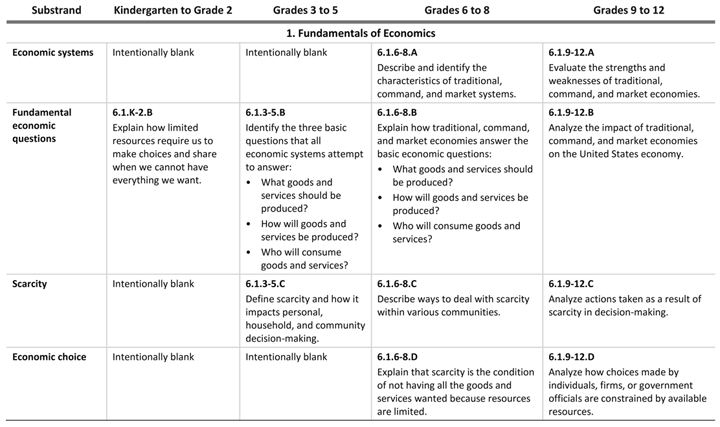
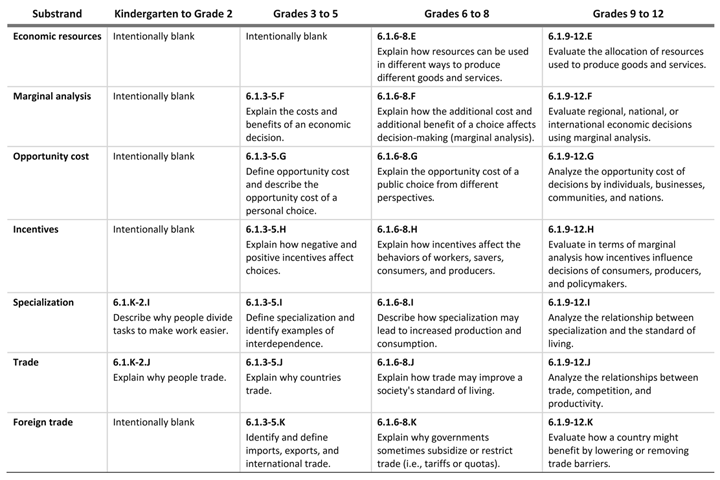
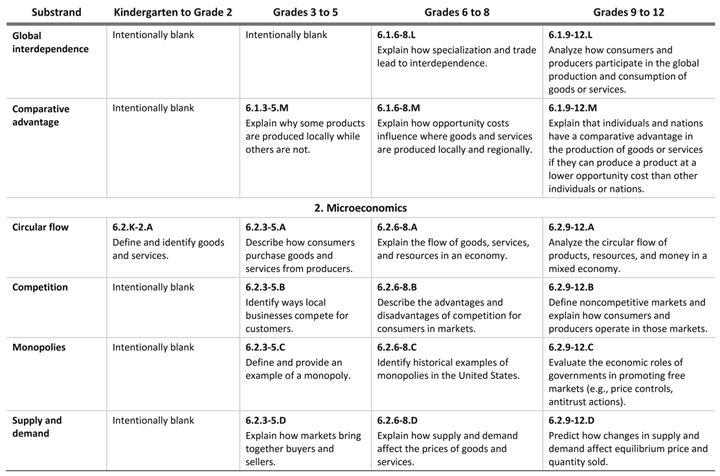
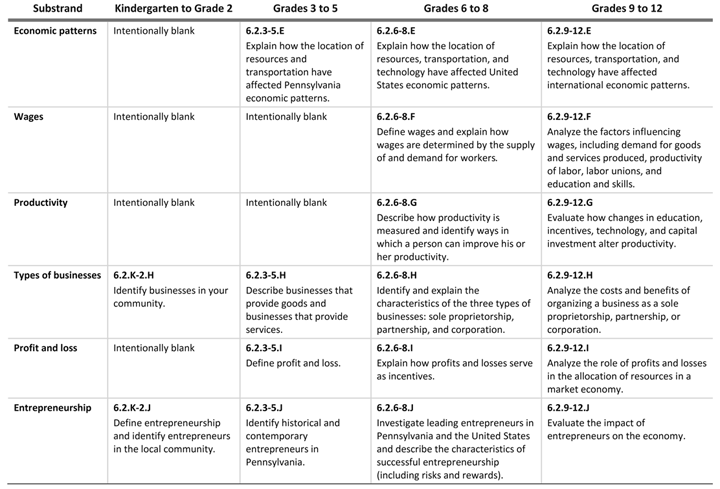
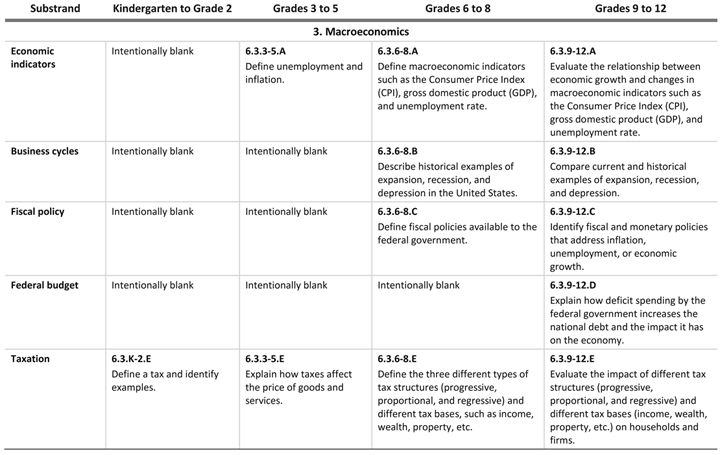
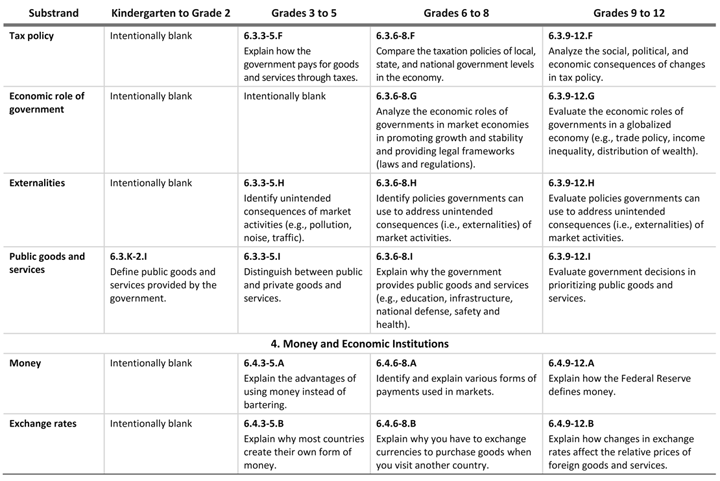
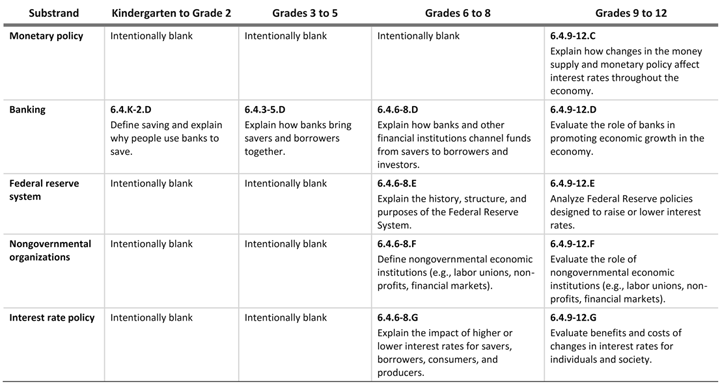
(Editor's Note: The academic standards for Family and Consumer Sciences in Appendix D, which appear in 22 Pa. Code pages 4-342—4-355, serial pages (295054) to (295066) and (320291), are proposed to expire July 1, 2026, and the academic standards for Family and Consumer Sciences in proposed Appendix D-1 are proposed to apply on and after that date.)
APPENDIX D
Academic Standards for Arts and Humanities and Health, Safety and Physical Education and Family and Consumer Sciences * * * * * (Editor's Note: The academic standards for Family and Consumer Sciences in Appendix D, which appear in 22 Pa. Code pages 4-342—4-355, serial pages (295054) to (295066) and (320291), are proposed to expire July 1, 2026, and the academic standards for Family and Consumer Sciences in proposed Appendix D-1 are proposed to apply on and after that date.)
APPENDIX D-1
Academic Standards for Family and Consumer Sciences
Grades K—12 Overview
This document includes Academic Standards for Family and Consumer Sciences at four grade levels (K—2, 3—5, 6—8, 9—12), with the emphasis on what students will know and be able to do in the following areas:
Number Areas 11.1 Food Science and Nutrition 11.2 Resource Management 11.3 Human Development, Family, & Relationships 11.4 Education and Early Childhood Development 11.5 Personal Finance and Consumer Skills 11.6 Career, Community, and Family Connections The Academic Standards for Family and Consumer Sciences emphasize the crucial role of families in shaping individual and community well-being. This educational approach underscores the shared responsibility of meeting diverse needs, promoting lifelong learning, and contributing to the community. The standards aim to prepare students not just for personal, family, and work responsibilities but also to empower them for the challenges of living and working in a diverse, global society, fostering holistic individual development and community advancement.
Family and Consumer Sciences (FCS) is a field of study focused on the science and art of living and working well in our complex world, encompassing family and consumer sciences, career exploration, community and family connections, consumer and family resource management, parenting and child development, food, nutrition, wellness, and family and interpersonal relationships.
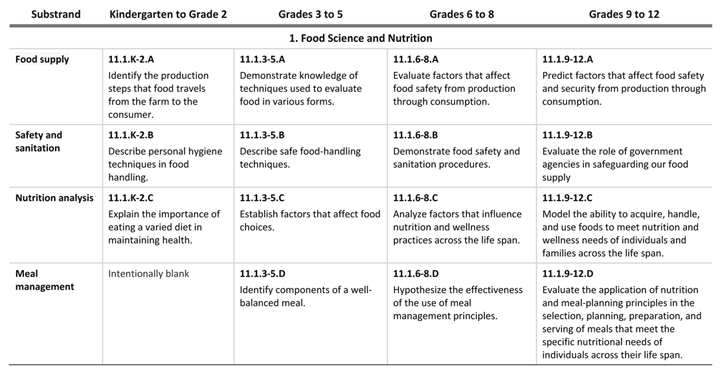
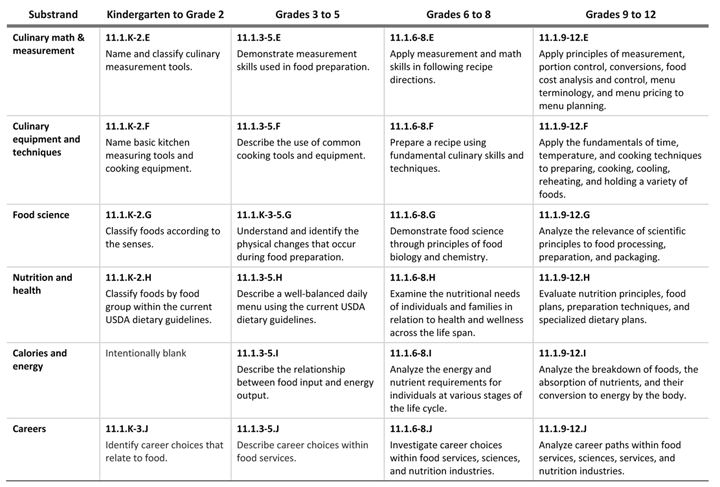
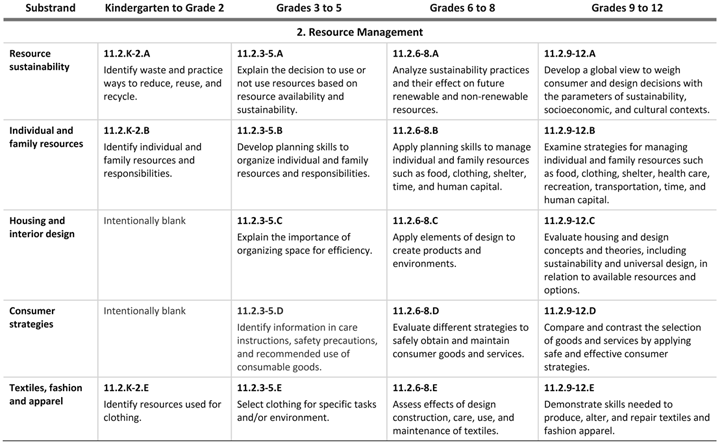
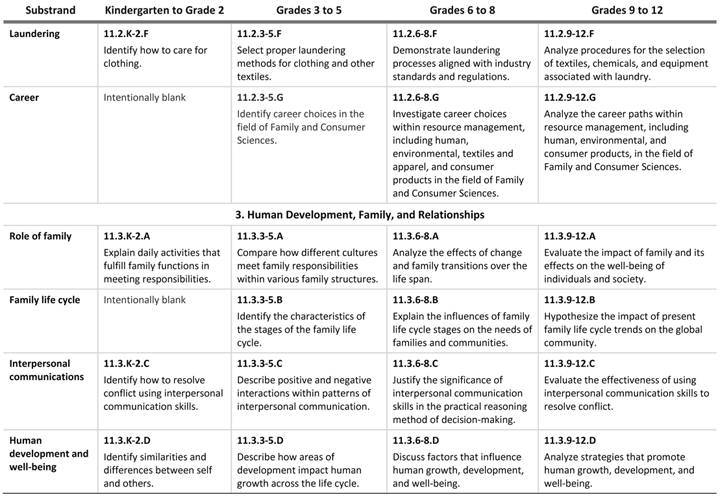
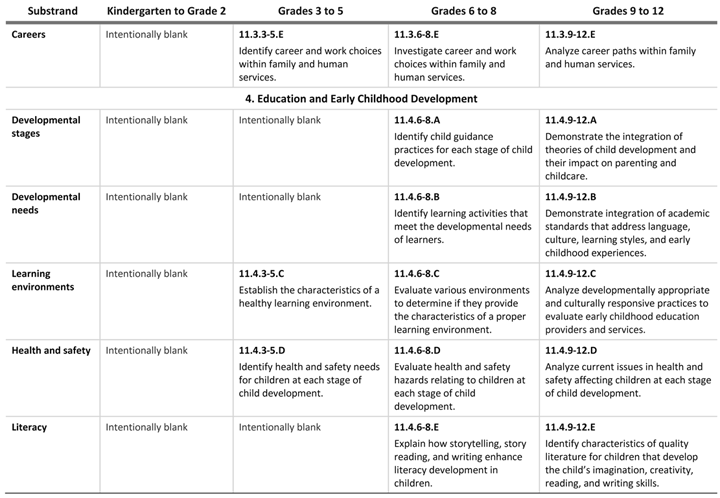
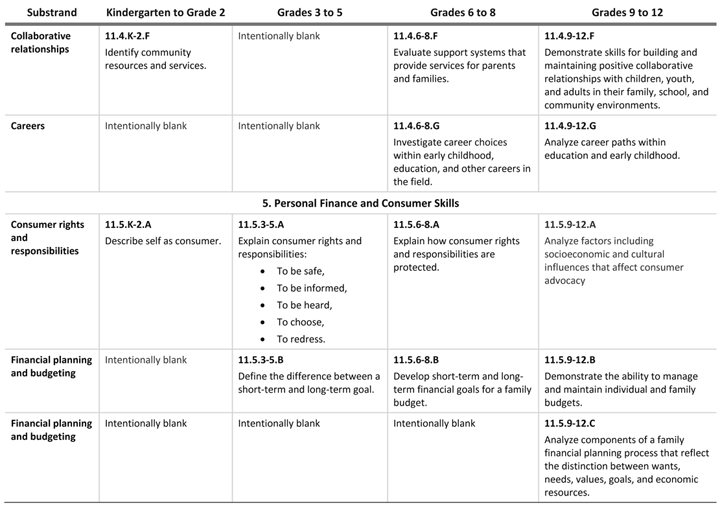
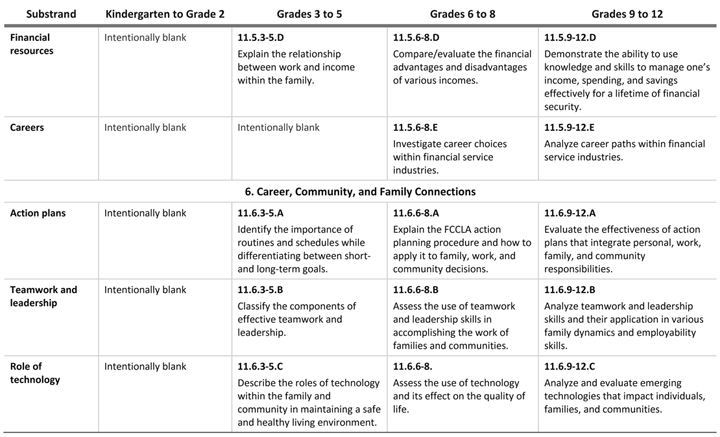

(Editor's Note: Appendix E, which appears in 22 Pa. Code pages 4-355—4-375, serial pages (320291) to (320300), (371245), (320303) to (320310) and (371247), is proposed to expire July 1, 2026, and the academic standards for Career Education and Work in proposed Appendix E-1 are proposed to apply on and after that date.)
[Continued on next Web Page]
No part of the information on this site may be reproduced for profit or sold for profit.This material has been drawn directly from the official Pennsylvania Bulletin full text database. Due to the limitations of HTML or differences in display capabilities of different browsers, this version may differ slightly from the official printed version.